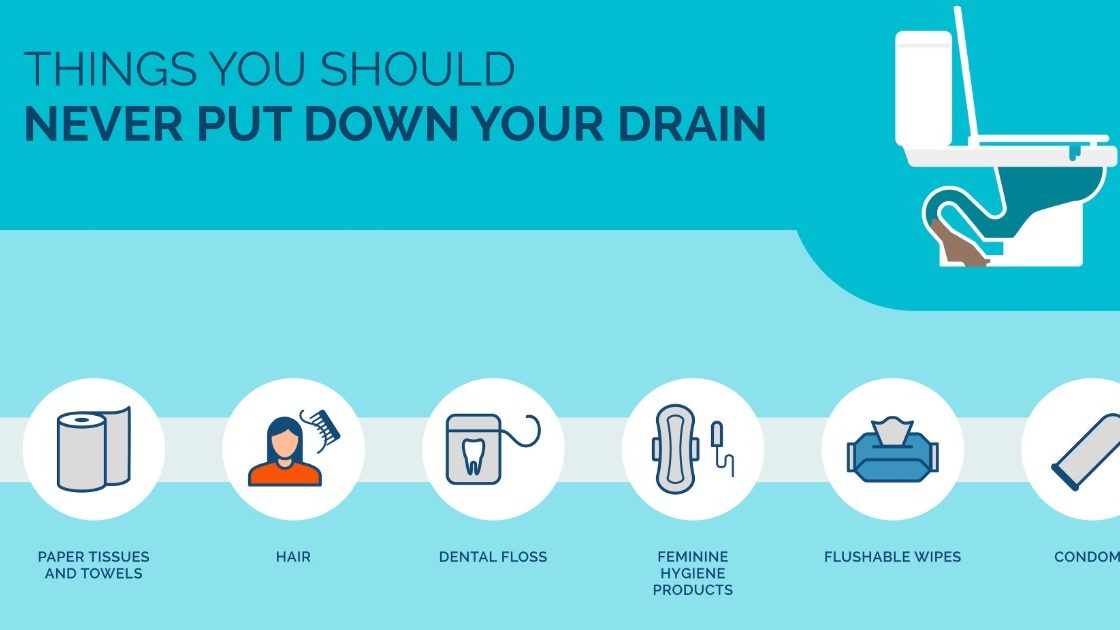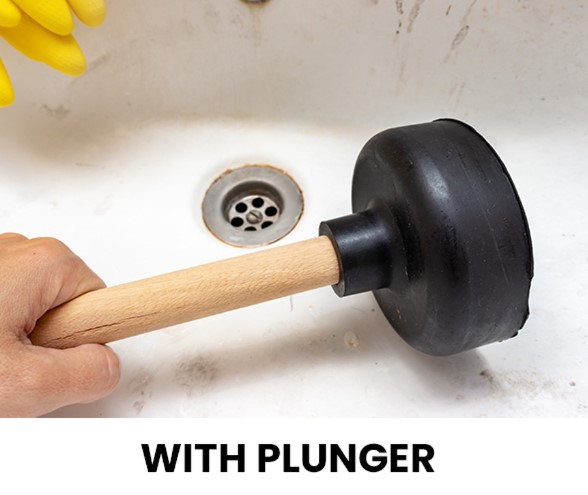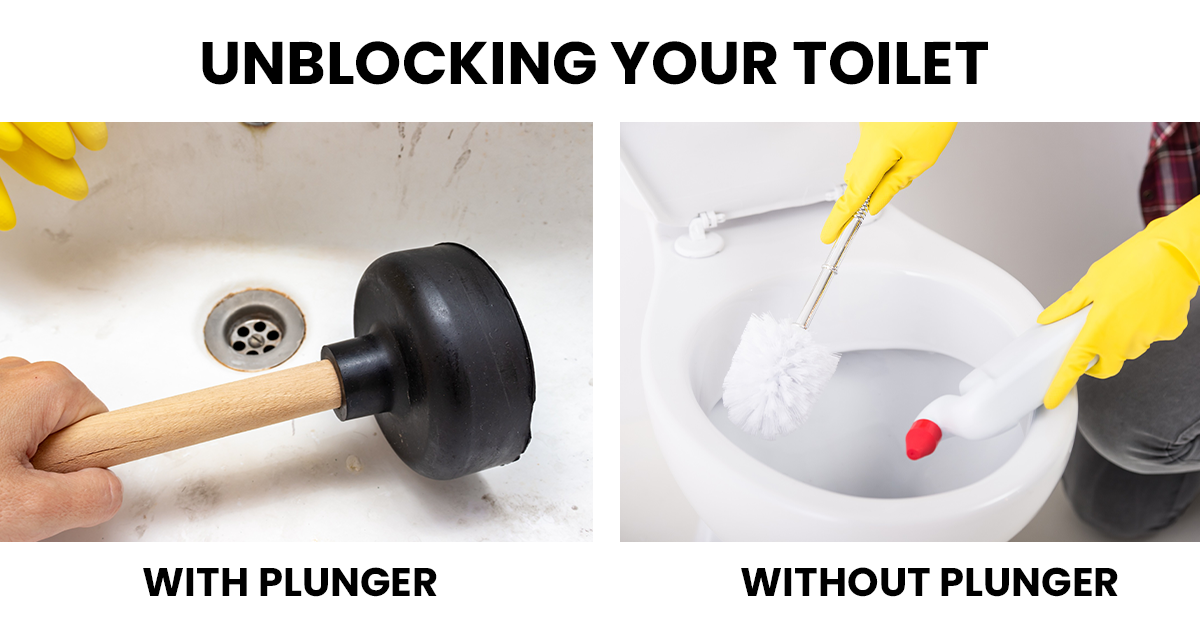Discovering your toilet is blocked can be a stressful and often messy problem to contend with. Whether it’s a simple blockage or something more stubborn, knowing how to tackle the issue quickly and effectively is essential.
At Any Drains Direct, we believe in empowering our customers with the knowledge to handle some of the most common plumbing issues. And so, in this comprehensive guide, we’ll walk you through how to clear a blocked toilet using a variety of methods, with or without a plunger, ensuring you’re covered for every scenario.
How to tell if your toilet is blocked
Sometimes you may suspect a toilet blockage but not know for sure.
Here are some key indicators of a blocked toilet:
- Water draining slowly from the toilet bowl, indicates a blockage is developing.
- When the bowl nearly empties after flushing, there’s an issue with air circulation in the waste pipes.
- When the water in the toilet bowl rises and remains high, the pipe is fully blocked.
If you’re unsure and don’t want to start immediately plunging away, you can rely on the expertise of a professional drainage team who will be able to use a range of tools and equipment to quickly and correctly diagnose the problem.
Common causes of a blocked toilet

Before we jump into solutions, it’s crucial to understand what causes toilet blockages.
If you know what to avoid, you can prevent future blockages from occurring.
Flushing inappropriate items
One of the most common causes of a blocked toilet is flushing objects that are not designed to be flushed down the toilet. This includes wet wipes, feminine hygiene products, and too much toilet paper. These items can quickly build up and cause a blockage in your pipes.
To avoid this, always remember to only flush toilet paper and human waste down the toilet. Keep a small bin in your bathroom for any other items that need to be disposed of.
Hard water deposits
If you live in an area with hard water, mineral deposits can build up in your pipes over time. This can lead to restricted flow and eventually cause a blockage.
To prevent this, consider installing a water softener in your home to reduce the mineral content in your water.
Tree roots
In some cases, tree roots can grow into sewage pipes and cause a blockage. This is more common in older homes with clay pipes or if you have large trees near your property. If you suspect tree roots may be the cause of your blocked toilet, it’s best to call a professional plumber to assess and fix the issue.
Before we get started…
So that you don’t end up flooding your bathroom before you get working on a fix, it’s wise to shut off the water supply to the offending toilet.
You can do this by closing the toilet flapper situated inside the cistern (it’s the bit that looks like a big sink plug with a chain attached) . You’ll want to have your protective gloves on here, but fret not, the water in the cistern is usually clean. Usually.
If you can’t see the flapper or you have a toilet with a push-button mechanism which means it may not have a visible flapper, you should turn off the property’s water supply with the stopcock instead.
Make sure everyone knows about the temporary water shutdown until the toilet blockage is fixed.
How to unblock a toilet (with a plunger)

Equipped with a larger-than-average rubber bell, a toilet plunger can create a strong vacuum seal that helps dislodge blockages.
Here are the steps to follow to unblock a toilet with a plunger:
Prepare the area
Before attempting to plunge your toilet, lay towels or newspapers around the base to catch any water that may spill over. It’s also a good idea to put on some rubber gloves to protect your hands from bacteria and germs.
Check the cistern
Begin by checking for blockages by removing the toilet cistern cover. If it has water, the blockage is deep in the waste pipe, and so you’ll need to use a plunger. If your plunging attempt is unsuccessful, call a plumber.
If the cistern is empty, the blockage is between the waste pipe and the toilet, and so you’ll be able to try other methods if the plunger fails.
Position the plunger
Place the plunger in the bowl, ensuring the flange (the extended lip) is directly over the waste pipe. The plunger should be submerged in water to create an effective seal. If necessary, add more water to the bowl to cover the plunger.
Create a vacuum seal
Gently press down on the plunger to expel air and establish a tight seal over the drain hole. The initial push is to get rid of trapped air, not to clear the blockage, so a gentle touch is crucial.
Plunge with vigour!
Once you have a good seal, use a forceful and consistent up-and-down motion to dislodge the blockage. The pressure created by the plunging action helps break apart the clog and push it down the pipes. Continue this motion for 15-20 seconds.
Break the seal and flush
After plunging, sharply pull the plunger up to break the seal. This sudden movement can help dislodge the blockage further. Check if the water drains from the bowl. If the water starts to go down, the blockage is clearing. Flush the toilet to ensure the blockage is completely removed. If the water clears, you’ve successfully unclogged the toilet! Hooray!
Repeat if necessary
If the water does not drain, or the toilet doesn’t flush normally, repeat the plunging process. It might take several attempts to clear tough blockages.
Cleanup
Once the toilet is unclogged, clean and disinfect the plunger and the area around the toilet. Wash your hands thoroughly with soap and water, even if you wore gloves.
By following these detailed steps, you can effectively clear most blockages in your toilet using a plunger. Remember, patience and persistence are key to successfully unclogging a toilet.
How to unblock a toilet (without a plunger)

If a plunger isn’t on hand, don’t worry—there are several effective methods to clear a blocked toilet:
Drain rod or toilet auger
Insert a drain rod/auger down the toilet to poke free the blockage. We appreciate that not everyone will have a drain rod or auger to hand, so you can use a straightened wire coat hanger for similar results, just be careful not to scratch the porcelain.
Soda crystals and vinegar
Using a blend of soda crystals and white vinegar allows you to create a homemade drain cleaner and offers an effective solution for clearing blockages. Simply place a small amount of crystals into the toilet, followed by half a cup of white vinegar. Allow it some time to work its wonders, then gently pour a kettle filled with boiling water into the toilet.
Baking soda and vinegar
This approach closely resembles the previous method, with the variation being the initial mixing of four tablespoons of baking soda and white vinegar in a cup. This creates a chemical reaction that can help break down any blockages. Once the mixture begins fizzing, pour it down the toilet and allow it to tackle the blockage for approximately five minutes. If a follow-up flush does not resolve the issue, consider repeating the process with additional baking soda.
Enzyme-based products
For organic material blockages, a product containing enzymes can break down the obstruction without causing the same harm to the environment that a chemical drain cleaner would. You can get these from most hardware stores and they are typically used.
Washing up liquid
This technique works particularly well for dealing with a clogged toilet caused by toilet paper. Grab a standard bottle of household washing up liquid and a bucket of water. Begin by squirting roughly half the bottle of washing up liquid into the toilet bowl where it will settle at the bottom. Then, pour in the bucket of water to push the washing up liquid through the u-bend. If you’re lucky, this should unclog the toilet.
Biological washing powder
Another option is to use biological washing powder. Simply grab two handfuls of your best-smelling biological washing powder and pour them down the toilet. Follow it up with boiling hot water from the kettle.
Wet-dry Vacuum
If you have access to a wet-dry vacuum cleaner (like your home one, but specially designed for handling water), it’s a good idea to give it a go on your toilet. Start by using the vacuum to empty the water from the toilet bowl and dispose of it. Then, insert the vacuum hose down the toilet and into the u-bend. Finally, seal the toilet bowl around the vacuum tube using a towel to create a tight seal. This powerful solution gives you a good chance of removing your toilet clogs with speed and efficiency.
What if I don’t have a plunger?
Good news – your household items could serve as suitable alternatives. Wrapping a mop head or toilet brush in plastic bags can create makeshift plungers. Although not as effective, they can provide a temporary solution until you get your hands on a real plunger.
Conclusion
Unblocking your toilet doesn’t have to be daunting. With the right approach and a little elbow grease, you can easily get things flowing smoothly again.
From traditional plunging methods to innovative, plunger-free techniques, there are numerous ways to tackle a blocked toilet. Often, a simple method can clear a blockage, restoring your plumbing to proper working order.
Remember, preventative measures can help avoid future blockages, so always be mindful of what goes down your toilet.
Still need help? Call the professionals
Sometimes, despite your best efforts, a blockage may require professional attention. If you’ve tried the methods above without success, it’s time to call in the experts from Any Drains Direct.
Our team of professionals is equipped to handle even the most stubborn blockages, ensuring your plumbing is back to normal in no time.
For professional help or advice on any drain unblocking needs reach out to our team today.
 01732 667 688
01732 667 688


